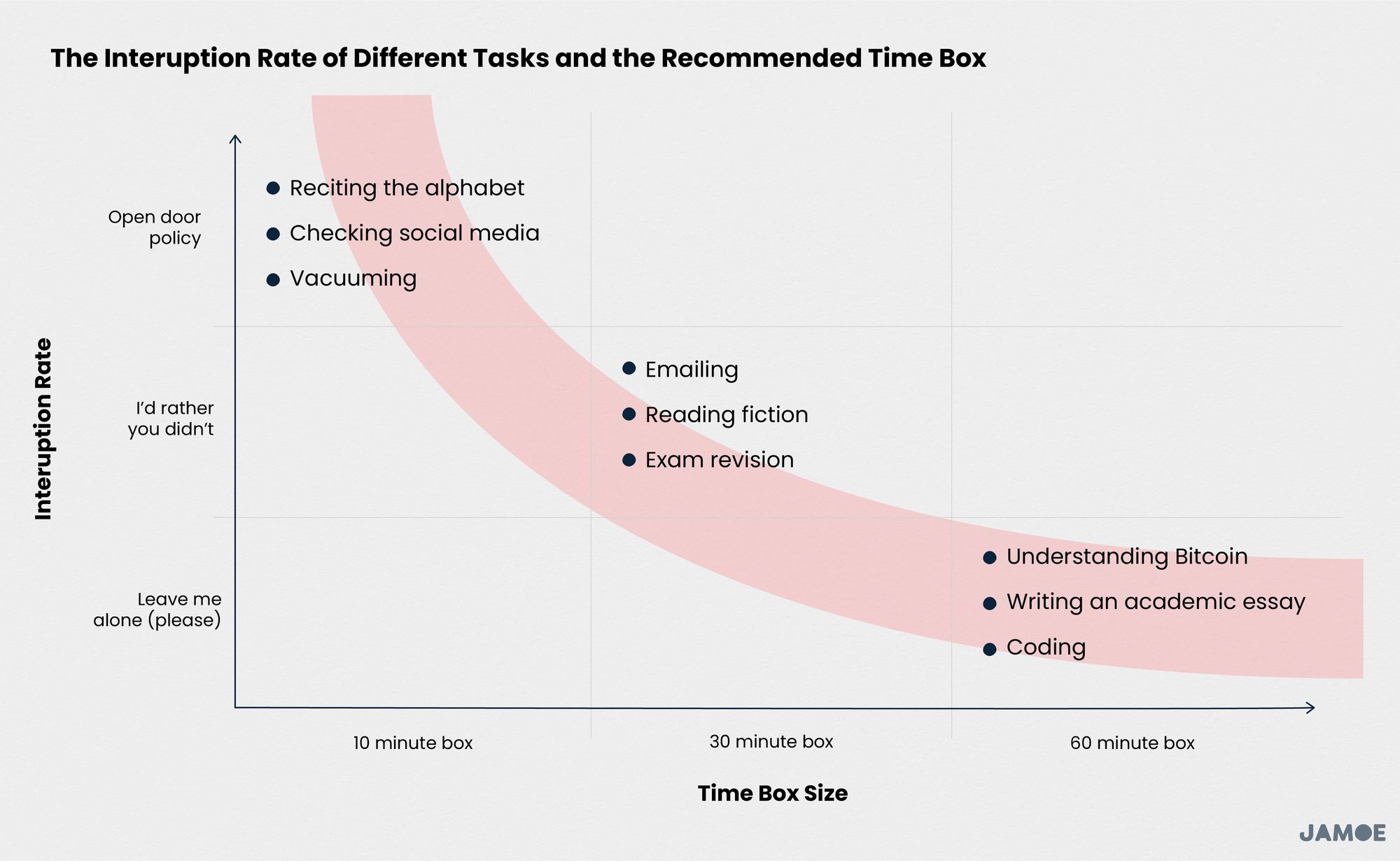Time Boxing: A Technique For Balancing Your Time Across Tasks
At a glance
- Based on the reader question: How do I balance my time across everything I have to work on? I'm currently studying A Level Chemistry, Biology, Maths and Geography. I usually spend too much time on one, so the others suffer. – Jason, Liverpool, UK
- Apply the counter-intuitive benefits of using time constraints to juggle multiple priorities and avoid having your work swell to fill whatever time you allot it.
- Balance time boxing with a way of measuring your performance, like Retrospective Revision Timetables, to ensure that you're focusing on what matters by working smart, not hard.
- Start thinking about tasks in terms of their interruption rate. If a task is more mentally taxing, use a larger time box, and be more fierce at shielding yourself from interruptions.
Introduction
Put a bottom under your bottomless pits.
When juggling competing priorities, time boxing is your safety net. Time boxing involves limiting how much time you spend on each to-do, whether it be for your studies or career, and moving onto the next thing. This stops tasks becoming infinite, and taking up more time than you have.
The rule of thumb is to set a 30 minute time limit on each task. However, some tasks need more or less time, so we'll also share a straight forward framework for deciding if you should use a small, medium, or large box.
Time is an input, and must be balanced against the desired output, so we'll also give consideration to measuring one's performance – this is especially helpful when you're trying to achieve a certain result, like passing an exam or hitting a sales target.
For advanced time boxers, we'll also introduce a new concept that we call the interruption rate.
Foundations: What types of tasks benefit from time boxing?
Bottomless pit tasks benefit most from time boxing. True to their name, they are tasks for which there is always a little bit more you could do:
- Revising for an exam (as one can never learn too much)
- Scrolling through a social media newsfeed (this feature is literally called an 'infinite scroll')
- Playing the 'Why-game' with a six-year-old[1]
These tasks, and others like them, are infinite. You can fall into them and never stop falling, but we can use a healthier approach by setting boundaries around how much time these tasks take from us.
Such is the art of honest productivity.
Foundations: How do I start benefitting from time boxing?
Set time limits. As a general guide, 30 minutes is an effective default length. For more advanced time boxers, we've included the nuance of small, medium, and large time boxes in the next section.
During your time box, your aim is to focus on the aspects of the tasks that will contribute most to the results you want: the highest return on investment, to steal the economics term.
When studying, this often involves focusing on the sub-topics that you're least comfortable with and completing an exercise to reaffirm your understanding, such as using Spaced Repetition or the Feynman Technique.
When it comes to keeping track of what to prioritise, Retrospective Revision Timetables – not to be mistaken with classic revision schedules – allow you to do this at a glance. It'll also keep you honest.
Once your time box ends, move onto the next task, like switching from revising Physics to Geography. With time boxing, you can chip away at these bottomless pit tasks, while ensuring that you aren't neglecting any of the things you need to get done.
When tackling these tasks, don't aim for perfection, but a push. That is, by the end of the session, aim to be at least 1% better off than when you started. These gains will compound, and add up to significant results across the plates you're spinning.
As you track your performance, you'll know which plates need more spinning than others. For example, if you still haven't figured out the mechanics of a supply and demand curve, you can give this more attention by reducing the time spent on the topics you find easier.
Advanced: When should I use smaller or larger time boxes?
'How large should my time box be?' is the natural follow up question when getting started with the technique.
As to not over-egg the pudding, you can think about your time boxes as coming in three sizes: small, medium, and large. Symbolically, these boxes represent 10 minutes, 30 minutes, and 60 minutes, respectively.
The size of the box you use depends on the task's mental load time. All tasks require us to load the problem into our head before attempting to solve them. You can think of this as building a mental house of cards. The more familiar the problem – like reciting the alphabet – the faster we can load the problem and start solving it.
However, some tasks can take hours to load, and being interrupted mid-flow causes your mental house of cards to come crashing down. Reading academic texts, solving a physics problem, filing your taxes – these are all prime examples.
Based on this observation, the frequency with which we can be interrupted varies based on how much cognitive crunching is required. We call this the interruption rate.
Low-brain power tasks have a high interruption rate. You can interrupt someone vacuuming without derailing their train of thought and compromising the cleanliness of the carpet.
High-brain power tasks have a low interruption rate. Interrupt a software engineer every few minutes, and you'll end up with a lot more bugs and a few more enemies.[2]
Summarising, the interruption rate can be expressed as:
Interruption rate: How often you can be interrupted when solving a problem without causing your mental house of cards to collapse.
It then follows that our North Star when using the time boxing technique is:
The lower the interruption rate, the larger the time box you should use.
Asking around the Jamoe team, we plotted some tasks based on how mentally taxing we find them, and this is how they spread across the small, medium, and large time boxes.

How this looks for you is a personal affair, but we hope it serves as a foothold for getting started.
Conclusion
We've looked at time boxing through the lens of studying, but it's by no means a one trick pony. Time boxing is a versatile and enduring technique for a mix of tasks, situations, and will help you get results in your studies and career.
It's also a helpful coaching technique for anyone finding themselves managing a team, and in a position where you have to help them juggle their workload.
Procrastination is the other great application for time boxing. At the core of procrastination is pain, the thought of doing a task actually feels painful in our mind's eye.
Setting a time box around the task, even something as small as 30 seconds, more often than not, kickstarts our engines. By setting an end point, we comfort our minds by assuring them that the perceived pain won't be endless – it'll just be [insert some tiny length of time into your timekeeping device].
As evidenced in the article, 'Motivation is a Myth':
You don’t need to feel motivated to get things done. You get things done to feel motivated. Motivation is the encouragement that follows from seeing the fruits of your labour, or anticipating the lazing about that follows on from a long day.
Footnotes
[1] ‘But why?’
[2] For anyone working at a technology company in a non-technical role, this is why software engineers tend to sport noise cancelling headphones, only check their notification periodically, and dislike meetings. It breaks their momentum. It’s also why open plan offices are the bane of those hired to do deep work: research, coding, financial modelling, accounting, design – it’s the equivalent of trying to build a house of cards in a wind tunnel.
This article is part of the Redraft newsletter, where we answer reader questions. Submit your question here or subscribe for free.
Learn faster. Think deeper. Stress less.




